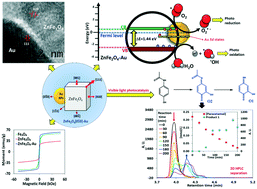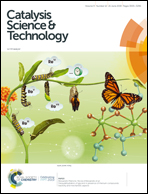Crystal phase induced band gap energy enhancing the photo-catalytic properties of Zn–Fe2O4/Au NPs: experimental and theoretical studies†
Abstract
Visible light assisted photo-catalysts are actively considered for the oxidation of contaminants as rapid water treatment. In this work, Au nanoparticles were grown on the surface of a ZnFe2O4 composite and used as photo-catalysts for the degradation of paracetamol. This type of deposition was chosen to enhance visible light absorption as well as to influence the 001 crystalline phase of Zn–Fe2O4 in order to reduce band-gap energy. Diffuse reflectance spectroscopy was employed to determine the band gap energy, which was then corroborated with the calculated band-gap energy (HOMO–LUMO) through the density of states using density functional theory (DFT). Furthermore, a high magnetic saturation (Ms) resulting from ZnFe2O4–Au NPs facilitated a quick recovery from the medium for reuse. The incorporation of Zn ions in the Fe sites of Fe3O4 reduced the Ms value and coercivity, considerably. However, the presence of Au NPs in Zn–Fe2O4 increased the Ms value with decreasing coercivity, exhibiting a noteworthy superparamagnetic behavior. The oxidation of paracetamol was studied under visible light using ZnFe2O4–Au NPs, showing an efficient visible light driven degradation. A first-order kinetics was observed for the substrate, for which a possible mechanism was proposed based on the DFT analysis. The surface passivation or modification of the catalyst was studied for ZnFe2O4–Au NPs by atomic force microscopy (AFM) to check whether there was any surface modification after being used for the oxidation. Interestingly, we used the 2D HPLC technique to characterize the intermediates as the separation of peaks was relatively low owing to the overlapping of peaks in the conventional HPLC method. The mechanism proposed for the oxidation is consistent with the energy profile of intermediates that resulted from the DFT studies. The interaction of all the materials with Saccharomyces cerevisiae cells was investigated for the development of green bio-imaging signals from ZnFe2O4–Au NPs.

- This article is part of the themed collection: 2019 Catalysis Science & Technology HOT Articles


 Please wait while we load your content...
Please wait while we load your content...